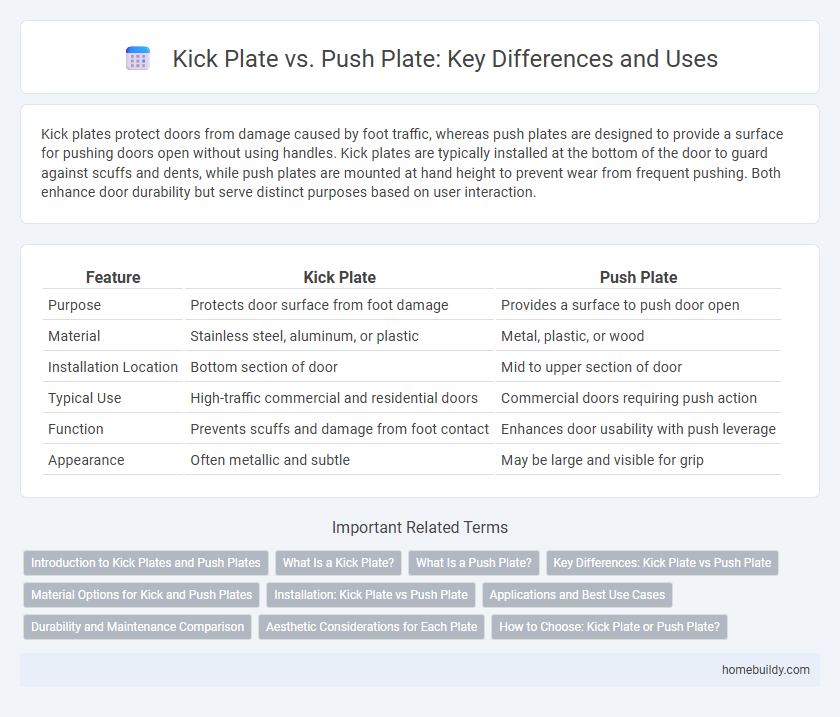Kick plates protect doors from damage caused by foot traffic, whereas push plates are designed to provide a surface for pushing doors open without using handles. Kick plates are typically installed at the bottom of the door to guard against scuffs and dents, while push plates are mounted at hand height to prevent wear from frequent pushing. Both enhance door durability but serve distinct purposes based on user interaction.
Table of Comparison
| Feature | Kick Plate | Push Plate |
|---|---|---|
| Purpose | Protects door surface from foot damage | Provides a surface to push door open |
| Material | Stainless steel, aluminum, or plastic | Metal, plastic, or wood |
| Installation Location | Bottom section of door | Mid to upper section of door |
| Typical Use | High-traffic commercial and residential doors | Commercial doors requiring push action |
| Function | Prevents scuffs and damage from foot contact | Enhances door usability with push leverage |
| Appearance | Often metallic and subtle | May be large and visible for grip |
Introduction to Kick Plates and Push Plates
Kick plates are protective metal or plastic panels installed at the bottom of doors to prevent damage from foot traffic, carts, and other impacts. Push plates, in contrast, are designed to provide a smooth surface for pushing doors open, typically mounted at hand height to reduce wear and improve hygiene. Both kick plates and push plates enhance door durability but serve distinct functional roles in commercial and residential settings.
What Is a Kick Plate?
A kick plate is a durable metal or plastic protective plate installed at the bottom of doors to prevent damage from foot traffic, carts, or equipment. Unlike a push plate, which provides a surface for hands to push the door open, a kick plate is specifically designed to absorb impact from kicks or strikes, enhancing door longevity. Common in commercial and high-traffic areas, kick plates improve both functionality and aesthetics by minimizing wear and tear on door surfaces.
What Is a Push Plate?
A push plate is a flat, durable metal or plastic plate installed on doors to prevent damage from frequent pushing, especially in high-traffic areas. Unlike kick plates, which protect the lower portion of the door from foot contact, push plates are mounted at hand level to safeguard against wear and tear caused by hand pushing. These plates are essential for maintaining door integrity in commercial and public buildings, ensuring longevity and reducing maintenance costs.
Key Differences: Kick Plate vs Push Plate
Kick plates are installed at the bottom portion of a door to protect against scuffs and damage from foot traffic, whereas push plates are mounted at hand height to prevent wear from repeated pushing. Kick plates are typically larger and made from durable materials like stainless steel or aluminum, designed for frequent contact with shoes or equipment. Push plates focus on ergonomic interaction and maintaining door aesthetics while facilitating easy door operation without handles.
Material Options for Kick and Push Plates
Kick plates and push plates are commonly made from materials such as stainless steel, aluminum, brass, and plastic, each offering different levels of durability and aesthetic appeal. Stainless steel kick plates provide superior resistance to corrosion and wear, making them ideal for high-traffic areas, while aluminum options are lighter and more cost-effective. Brass and plastic plates offer decorative or budget-friendly alternatives, with push plates typically available in similar materials but designed for less impact resistance compared to kick plates.
Installation: Kick Plate vs Push Plate
Kick plates install at the bottom of doors to protect against scuffs and damage from foot traffic, requiring screws or adhesive fasteners aligned with door material for secure mounting. Push plates mount at hand height, designed to absorb impact from hand or arm contact, typically affixed with screws or strong adhesive tapes suited for high-touch areas. Both plates must be positioned accurately for functionality and durability, with installation tools and surface preparation varying based on door type and plate material.
Applications and Best Use Cases
Kick plates are ideal for high-traffic areas where door protection from foot or object impact is critical, such as commercial kitchens, hospitals, and warehouses. Push plates are best suited for doors primarily operated by hand, providing a durable surface to prevent wear and maintain hygiene in office buildings and retail stores. Choosing between kick plates and push plates depends on the specific door use, with kick plates excelling in foot-driven environments and push plates designed for hand contact.
Durability and Maintenance Comparison
Kick plates, typically made from heavy-duty materials like stainless steel or aluminum, offer superior durability against frequent impact and abrasion compared to push plates. Their resistance to dents, scratches, and corrosion reduces maintenance needs, making them ideal for high-traffic areas. Push plates, often lighter and less robust, require more frequent replacement or repairs due to wear from constant hand pressure and environmental exposure.
Aesthetic Considerations for Each Plate
Kick plates provide a sleek, durable surface that enhances door aesthetics by protecting lower sections from scuffs while maintaining a seamless look. Push plates, designed for hand contact at mid-door height, often offer more decorative options to complement interior design styles. Choosing between kick plates and push plates depends on the desired balance between functionality and visual appeal in high-traffic areas.
How to Choose: Kick Plate or Push Plate?
Choosing between a kick plate and a push plate depends on the door usage and protection needs. Kick plates, typically made of stainless steel or aluminum, shield doors from foot and furniture damage in high-traffic areas. Push plates are designed specifically to prevent wear from hands and facilitate smooth door operation without the need for handles.
Kick plate vs Push plate Infographic

 homebuildy.com
homebuildy.com